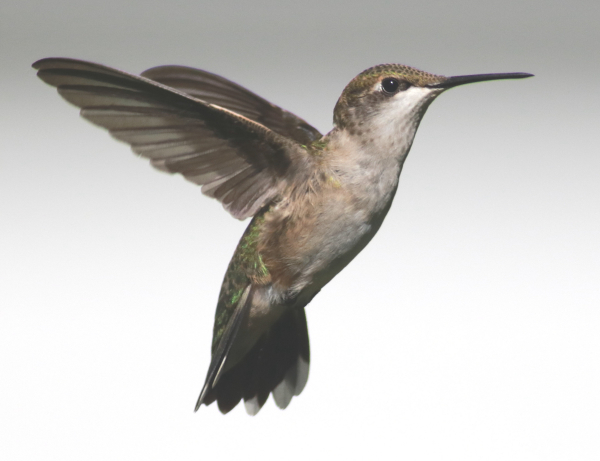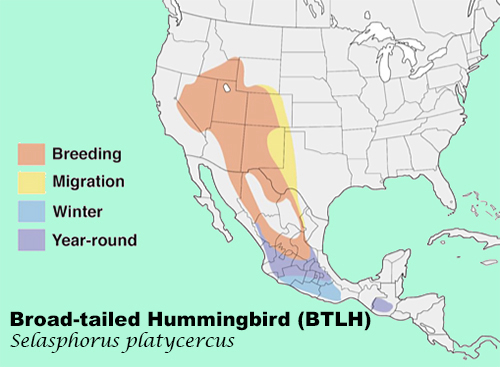
Ruby-throated Hummingbirds are the primary focus of Operation RubyThroat at Hilton Pond Center, South Carolina (photo by Paul Konrad).

Range of Broad-tailed Hummingbirds (map by Hilton Pond Center).
|
As hummingbird migration reached a peak in southern states last week, our attention turned to an outstanding hummingbird haven and the work that goes on there – literally in the backyard of a noted birder and biologist, Bill Hilton Jr. As home to Operation RubyThroat since 1984, the Hilton Pond Center for Piedmont Natural History in York, South Carolina focuses in part on studying Ruby-throated Hummingbirds. Through September 21 they have banded 6,889 Ruby-throated Hummingbirds at the Center, and some of those banded hummers have returned during 1 to 7 subsequent summers.
Their banding work has provided insightful discoveries about Ruby-throated Hummingbird sex ratios, longevity, survivorship, site fidelity, foraging behavior, and population dynamics, which have added significantly to the scientific understanding of Ruby-throated Hummingbirds. At the same time, that information is very useful in planning conservation efforts. After 38 years, Operation RubyThroat is one of the world’s longest-running hummingbird projects, but they are always learning something new – as happened last week when they captured a different hummingbird species never before reported from South Carolina!
Sound exciting? Here’s the story:
On the morning of September 20th we arose shortly after dawn and deployed several mist nets as part of our general bird banding program. Traps containing hummingbird feeders mostly catch hummingbirds, but nets are non-selective; thus, they’re just as likely to catch fall migrating warblers or resident Carolina Wrens as Ruby-throated Hummingbirds. In other words, we never know what we might encounter on our regular net checks.
During the 9am check on the 20th, we noticed a hummingbird in a net near several sugar water feeders directly behind the Center’s old farmhouse. When we took the hummer out of the net we saw it was slightly larger than a typical female Ruby-throated Hummingbird. In addition we immediately noticed the wing was rather long and that the outermost primary feather was straight with a thin vane on the leading edge. This was quite different from the configuration of a Ruby-throated female’s wider, slightly curved outer primary.
More measurements and observations revealed the true identity of the hummingbird – a Broad-tailed Hummingbird! In dorsal view the adult female Broad-tailed Hummingbird looked very much like an adult female Ruby-throat, except the long wings again stood out.
The folks at Hilton Pond can only speculate what conditions or stimuli brought this western vagrant to South Carolina and the Hilton Pond Center far east of its normal migration range in the Southwest region of the United States and the species’ winter range in Central Mexico (see map). They’re just glad to find a Broad-tailed Hummingbird wanderer stopped by to become the first documented Broad-tailed Hummingbird in South Carolina!
Actually, it can be counted as an advance present for Bill Hilton Jr’s 75th birthday! If you would like to read more about the experience of identifying the Broad-tailed Hummingbird while it was “in hand,” refer to http://www.hiltonpond.org/ThisWeek210915.html
This Broad-tailed Hummingbird find is included in the Rare Birds article in this issue of The Birding Wire, along with many other state records and off-course birds documented across the United States and Canada during the past week or so.
Note: If you live east of the Mississippi River and see a hummingbird that’s not a Ruby-throated Hummingbird at your feeders at any time, or if you observe a hummer of any species between October 15 and March 15, please try to get a clear photo of it and contact the biologists at the Hilton Pond Center via email at research@hiltonpond.org
Share your backyard birding experiences and photos at editorstbw2@gmail.com